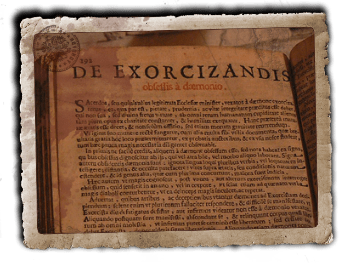Roman Ritual

The Rituale Romanum : Catholic priest’s service manual that includes the only formal Exorcism rites sanctioned by an established church. First written in 1614 under Pope Paul V, the Rituale Romanum remained untouched until 1952, when two small revisions were made in the language. More revisions were done by the Second Vatican Council (1962–65), and the rite was reissued in 1999.
The Rituale includes rites for Baptism, confirmation, the Holy Eucharist, penance, anointing the sick, marriage, the holy orders of priesthood, the seven pentential psalms and liturgy of the saints, death and burial, blessings, processions, and litanies, besides exorcism. As early as its 17th-century publication, the Rituale strongly cautions the priest against exorcism when no true Possession exists. As medical science further defines illnesses previously thought to be the result of Demonic interference—hysteria, epilepsy, multiple personality disorder, schizophrenia, paranoia, sexual dysfunction, and other neuroses brought on by childhood terrors and obsessions—determining true possession has become increasingly difficult.
The 1952 revisions change the wording that symptoms of possession “are signs of the presence of a Demon” to “might be.” Those in alternative states to possession, originally described as “those who suffer from melancholia or any other illness,” became “those who suffer from illness, particularly mental illnesses.” Many devout Christians have turned away from the idea of possessing Demons at all.
More revisions were undertaken by the Second Vatican Council. Since 1999, the exorcism portion has been reissued in a new 90-page document, De Exorcismus et Supplicationibus Quibusdam (Concerning Exorcisms and Certain Supplications). The rite includes prayers and passages from the Bible and calls upon the Demons, in powerful Latin, to depart in the name of Jesus Christ. The new version eliminates some of the rough medieval language used to describe the Devil. And instead of having the exorcist command the Demons or Devil to leave the victim, the exorcist now calls on God to command the Demons to leave.
Guidelines also were issued stating that exorcisms should not be performed as part of healing services or masses, especially any involving hysteria, theatrics, or sensationalism.
However, if the victim exhibits paranormal capabilities, shows superhuman strength, and, most importantly, manifests knowledge of previously unknown languages, then he or she is a possible candidate for Demonic exorcism.
If such symptoms accompany extreme revulsion toward sacred texts and objects, then the church may deem the victim possessed. With permission from a bishop, the exorcist begins the ancient ritual.
Exorcism is not a sacrament but a rite and is not dependent on rigid adherence to a set of actions. Rather, exorcism relies on the authorization of the church and the faith of the exorcist. The exorcist is free to vary the procedure, substituting his own favourite prayers, altering the sequence of events, or speaking in his own language. Most exorcists have found, however, that Latin particularly bothers evil spirits.
The Rituale exhorts the exorcist to make sure that the victim is possessed and not suffering from mental illness.
Even during exorcism, the priest should continue to question the victim about his or her mental and spiritual state. Under no circumstances should the exorcist offer medicine to the victim, leaving such work to the medical practitioner. If the possessed is a woman, the exorcist should be assisted by a strong woman, preferably from the possessed’s family, to prevent any hint of scandal. The possessed should hold a crucifix during the exorcism, and the exorcist is encouraged to use holy water and relics, recite passages from the Bible, and liberally make the sign of the cross over the victim. Finally, the exorcist should speak in a commanding voice, only questioning the Devil about his name, the number of Demons in possession, where they are from, and how they got there.
Before beginning, the priest should make confession. Then, donning a surplice and purple stole (required of an exorcising priest), the exorcist stands before the possessed and recites the Litanies of the Saints, the Pater Noster (the Lord’s Prayer), and Psalm 53. He calls upon the Demon to state why it is possessing the victim and when it intends to depart. The Demon is asked to name itself, giving the exorcist an advantage. The exorcist gives more Scripture readings, then does a laying on of hands. He calls upon God to command the Demon to leave, then enjoins the spirit to succumb to Jesus and depart back to Hell, the depths of gehennam.
Each recitation is accompanied by more prayers, including the Ave Maria (Hail Mary), the Gloria Patri (Glory Be to the Father), the Anima Christi (Body of Christ), the Salve Regina (Save us, merciful Mary), the sign of the cross, and Scripture readings. The Demon is enjoined a second time; the exorcist repeats each of these acts until the Demon leaves permanently.
The victim, released from evil, is then encouraged to profess faith in Christ and refrain from evil thoughts and actions so as to provide no haven for devils in the future. More prayers are said, and then, finally, the exorcist asks the Lord’s help in protecting the victim from further harm. Exorcising Demonic infestation of a place rather than a person follows a shorter ritual. The priest invokes the archangel Michael to intercede with Christ on behalf of the church and to crush the serpent. This call is followed by a formal announcement of the exorcism, prayer, then an address to Satan and his legions to leave the place and harm it no longer. The priest offers more prayers, always accompanied by the sign of the cross, and blesses the place with holy water.
FURTHER READING:
- Martin, Malachi. Hostage to the Devil. New York: Harper & Row, 1976.
- Oesterreich, Traugott K. Possession and Exorcism. Secaucus, N.J: University Books, 1966.
- Wilkinson, Tracy. The Vatican’s Exorcists: Driving Out the Devil in the 21st Century. New York: Warner Books, 2007.
SOURCE:
The Encyclopedia of Demons and Demonology – Written by Rosemary Ellen Guiley – Copyright © 2009 by Visionary Living, Inc.











